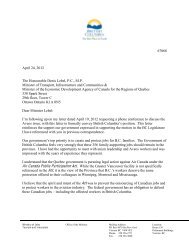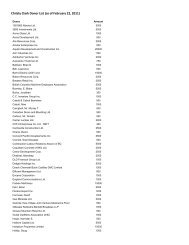from the ground up - The Tyee
from the ground up - The Tyee
from the ground up - The Tyee
Create successful ePaper yourself
Turn your PDF publications into a flip-book with our unique Google optimized e-Paper software.
So Much Rain! Why Not Put It To Work?Exasperated that our wet winters turn into water-scarce summers? Get yourown 1000-gallon rain barrel.By Christopher PollonArticle first published on March 24, 2011 by <strong>The</strong><strong>Tyee</strong>.ca.DANGER: Drinking this toilet water could be hazardousto your health.That’s <strong>the</strong> message required above every rainwaterflushingtoilet installed at Vancouver’s Olympic Village,where water is collected <strong>from</strong> <strong>the</strong> roof, stored ina giant holding tank, and pumped as needed for eachflush.<strong>The</strong> sign is necessary, because bringing rain indoorsbreaches a fundamental orthodoxy of <strong>the</strong> North Americanplumbing world: behind <strong>the</strong> walls, pipes carryingpotable municipal water mingle with those carryingpotentially unsanitary rain. On paper, building codesfor Vancouver and elsewhere in B.C. do not currentlyallow <strong>the</strong> practice of indoor rain water plumbing. Ina post-Walkerton regulatory environment, <strong>the</strong>re isimmense discomfort on <strong>the</strong> part of building inspectorsat <strong>the</strong> prospect of mixing private and public waters<strong>up</strong>plies. (See sidebar.)In spite of this, <strong>the</strong>re are about 25,000 rain watercapture systems operating across B.C. today -- used towater lawns and crops, flush toilets and provide drinkingwater for people and livestock. <strong>The</strong>re are about5,000 rain systems on Vancouver Island and <strong>the</strong> GulfIslands alone, in areas where seasonal droughts anddodgy well water make it a necessity.As municipalities and cities explore ways to workwith <strong>the</strong> deluge of water that falls <strong>from</strong> <strong>the</strong> sky (morethan a metre of rain typically falls annually in Vancouver),<strong>the</strong> most promising use will be for irrigationof lawns and gardens in <strong>the</strong> near future. This could begood and bad.“I have a worry that rainwater is starting to gettrendy,” says Bob Burgess, a B.C. rainwater harvestingpioneer and founder of <strong>The</strong> Rainwater Connectionwhich designs and builds all sorts of rain capturesystems. “More and more people are doing it, anddoing terrible jobs of it. It may not be too long beforewe have our little Walkerton for rainwater.”Looking to <strong>the</strong> skiesA basic rain harvesting system captures water <strong>from</strong> aroof and channels it to a storage tank, where it is <strong>the</strong>npumped to where it is needed. Along <strong>the</strong> way, <strong>the</strong> rainundergoes any number of different filters and cleaningmethods depending on <strong>the</strong> end use: to make it potablefor drinking, it will require filtration and any combinationof UV sanitizing and chlorine-injection; waterstrictly for watering plants will be cleaned less.Big municipal fleets are among <strong>the</strong> early adopters:White Rock currently washes some of its trucks withrain, as does Vancouver; <strong>the</strong> Regional District of Nanaimocaptures rain off two large Parksville recyclingtransfer buildings and uses it to wash <strong>the</strong>ir interior65








